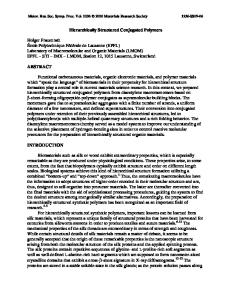Molecular Assemblies, Patterning, and Deposition of Conjugated Polymers: Ultrathin Films Prepared using the Layer-by-Lay
- PDF / 271,946 Bytes
- 6 Pages / 612 x 792 pts (letter) Page_size
- 89 Downloads / 352 Views
Molecular Assemblies, Patterning, and Deposition of Conjugated Polymers: Ultrathin Films Prepared using the Layer-by-Layer and Precursor Polymer Electrodeposition Approach Rigoberto Advincula*, Mi-kyoung Park and Chuanjun Xia Department of Chemistry, University of Alabama at Birmingham Birmingham, AL 35294-1240 ABSTRACT In this paper we present a combined protocol for ultrathin film formation and assembly of πconjugated polymer materials using the layer-by-layer (LbL) technique and a precursor polymer approach to electrodeposition. While much work has been done on investigating the chemistry (synthesis) and properties (physics) of these materials, little focus has been given on the multilayer and ordering issues associated with ultrathin film formation especially using novel “wet-processing” approaches. This work details our molecular assembly approaches on conjugated polymer systems for polyfluorene and polythiophene derivatives. This was demonstrated in the following systems: a) ionene precursor polyfluorene polymers deposited as ultrathin films using the LbL technique from an aqueous solution and b) electrodeposition of polysiloxane modified precursor polymers. Important strategies are outlined for combining the two techniques as a novel method for preparing ultrathin films and patterning. INTRODUCTION The study of π-conjugated polymer materials has been a subject of great interest for many years now [1]. Their properties and synthesis have been widely studied over the past decade, both for fundamental reasons and potential applications. The recent Nobel prize awarded to MacDiarmid, Heeger, and Shirakawa attest to the importance of this field and their applications. Because the polymers are often intractable and rigid, their properties needs to be tailored for solubility by choosing proper substituents (usually alkyl groups) that are incorporated in their design and synthesis. The most studied groups include: polyanilines, polypyrroles, polythiophenes, polyfluorenes, etc.[1]. These polymers, bearing properly designed side groups, can undergo striking conformational and chemical changes when exposed to heat, light, electric fields, various chemical moieties (dopants) giving rise to conductivity, fluorescence, reversible thermochromism, photochromism, electrochromism, and even ionochromism. Thus, they have found applications as conducting polymers, polymer light emitting diode (PLED)[2], field-effect transistor (FET) devices [3], sensors, and lasers. All these applications require well-defined electronically and optically active thin films. While a number of techniques has been investigated using the traditional solid-state processing techniques such as vacuum deposition, spin-coating, lithography, etc. not much focus has been given using "wet processing" ultrathin film strategies such as; a) LB film deposition, b) layer-by-layer (LbL) deposition techniques, c) electropolymerization of polymers, etc. While most conjugated polymers are inherently intractable, their limited solubility can actually be used to their ad
Data Loading...











